Comparing the climate experienced during the Cicerone farmlet experiment against the climatic record
K. Behrendt A E , J. M. Scott B , D. F. Mackay C and R. Murison DA Graham Centre for Agricultural Innovation (NSW Department of Primary Industries and Charles Sturt University), School of Agricultural and Wine Science, Charles Sturt University, Orange, NSW 2800, Australia.
B School of Environmental and Rural Science, University of New England, Armidale, NSW 2351, Australia.
C 3 Jayne Close, Armidale, NSW 2350, Australia.
D School of Science and Technology, University of New England, Armidale, NSW 2351, Australia.
E Corresponding author. Email: kbehrendt@csu.edu.au
Animal Production Science 53(8) 658-669 https://doi.org/10.1071/AN12300
Submitted: 22 August 2012 Accepted: 13 June 2013 Published: 10 July 2013
Journal Compilation © CSIRO Publishing 2013 Open Access CC BY-NC-ND
Abstract
Farming systems research conducted under dryland conditions is subject to the vagaries of the climate during the experimental period. Whether such an experiment experiences a representative series of climatic years must be examined in relation to the longer term climatic record. The Cicerone Project’s farmlet experiment was conducted on the Northern Tablelands of New South Wales, Australia, to investigate the profitability and sustainability of three different management systems: one managed under typical, moderate-input conditions (farmlet B); a second which employed a higher level of pasture inputs and soil fertility (farmlet A); and a third which focussed on the use of moderate inputs and intensive rotational grazing (farmlet C).
The climate experienced during the 6.5-year experimental period was compared with the 118-year climatic record, using a biophysical simulation model of grazed systems. The model utilised the long-term daily climate data as inputs and provided outputs that allowed comparison of parameters known to affect grazed pastures. Modelled soil-available water, the number of soil moisture stress days (SMSDs) limiting pasture growth, and growth indices over the experimental period (2000–06) were compared with data over the climatic record from 1890 to 2007. SMSDs were defined as when the modelled available soil moisture to a depth of 300 mm was <17% of water-holding capacity. In addition, minimum temperatures and, in particular, the frequency of frosts, were compared with medium-term (1981–2011) temperature records.
Wavelet transforms of rainfall and modelled available soil water data were used to separate profile features of these parameters from the noise components of the data. Over the experimental period, both rainfall and available soil water were more commonly significantly below than above the 95% confidence intervals of both parameters. In addition, there was an increased frequency of severe frosting during the dry winters experienced over the 6.5-year period. These dry and cold conditions were likely to have limited the responses to the pasture and grazing management treatments imposed on the three farmlets. In particular, lower than average levels of available soil water were likely to have constrained pasture production, threatened pasture persistence, and reduced the response of the pasture to available soil nutrients and, as a consequence, livestock production and economic outcomes.
Ideally, dryland field experimentation should be conducted over a representative range of climatic conditions, including soil moisture conditions both drier and wetter than average. The drier than average conditions, combined with a higher than normal frequency of severe frosts, mean that the results from the Cicerone Project’s farmlet experiment need to be viewed in the context of the climate experienced over this 6.5-year period.
Additional keywords: available soil moisture, climate variability, farming systems research, growth indices, soil moisture stress days.
Introduction
When interpreting the results of a dryland farming systems experiment, the climate experienced during the experimental period needs to be considered (Walker 1988). In the Cicerone Project’s farmlet experiment, individual paddocks were allocated without bias across the experimental area (159 ha) to ensure contiguous farmlets (Scott et al. 2013d), and hence, we have assumed that each farmlet experienced the same climate over the trial period. However, the question remains whether the climate over the 6.5 years of the trial was sufficiently representative of the long-term climate to permit adequate testing of the farming system treatments.
Typically, field experiments report the climatic conditions during an experimental period but rarely consider how it relates to climatic records over the long term (Laws et al. 2000; O’Reagain et al. 2011). Climate is especially important when the treatments being evaluated, such as changes in soil fertility and botanical composition, are known to take many years to reach equilibrium (Walker 1988; Jones et al. 1995).
The effect of climate on farming systems research conducted as field experiments has received relatively little attention in the literature, with most recent farming systems studies employing modelling to investigate issues of climate (Keating and McCown 2001; Moore 2009). The cumulative effects of rainfall, evaporation, and temperature during an experimental period are difficult to express over time, and there is a need to consider variability as well as averages (Tucker 1975; Johnson 1997; Katz and Brown 1992).
Temperature and rainfall variability affect farm performance largely through their impact on soil water content, which, in Australia, is arguably the most important constraint on pasture production (Stafford Smith and McKeon 1998; Lodge and Johnson 2008a). Using a simulation model, Stafford Smith and McKeon (1998) identified total soil moisture as the single best measure of drought and grassland stress events in Australian rangeland systems. Similarly, Lodge and Johnson (2008a) used the Sustainable Grazing Systems pasture model (Johnson et al. 2003) to simulate daily soil water content in four different temperate pasture types. They defined a drought period as having ≥50 consecutive days of soil water deficit, which corresponded to a volumetric soil water content at which pasture growth would be limited in the range 9.5–30.5% across the different soil types.
McCaskill and Blair (1988) modelled soil water on the Northern Tablelands of New South Wales (NSW) and found that, when available soil moisture was <17% of water-holding capacity, the conditions were likely to severely restrict growth of the best adapted legume in the region, white clover (Trifolium repens), with consequences for nitrogen fixation and, ultimately, pasture growth. Using this threshold, McCaskill and Blair (1988) calculated the number of such days per year, which they termed ‘critical clover days’ (CCDs), and compared average CCDs per year over different decades. They reported that a period of relatively low stress conditions for white clover occurred during 1950–79, which coincided with the time when large areas of the region were sown to introduced species. McCaskill and Blair (1988) suggested that white clover may not persist under the climatic conditions more typical of long-term records, and recommended that climatic experiences over the long term need to be considered when assessing the likelihood of pasture or animal growth in response to treatments.
The Cicerone Project’s farmlet experiment was created to investigate the sustainability and profitability of three farm-management systems on the Northern Tablelands of NSW (Sutherland et al. 2013). The experiment was conducted on three farmlets, each of 53 ha, over the period July 2000–December 2006. Farmlet A represented a high-input, flexible grazing system; farmlet B represented a moderate-input system, typical of district practice, with the same flexible grazing system as farmlet A; and farmlet C represented an intensive rotational grazing system with more than four times as many paddocks as the other farmlets but with the same moderate inputs as the typical-practice farmlet (B).
The climate of the Northern Tablelands is representative of the temperate, summer-dominant, high-rainfall region of south-eastern Australia; typically, the rainfall is highly variable between years and seasons (Johnson 1997). There is evidence that the rainfall in this region is changing, both between years and between seasons (Russell 1981). Carberry et al. (2005) reported that, over the 52 years between 1952 and 2004, Armidale experienced higher winter rainfall than the long-term average (1872–2004) in only 15 years, whereas below-average winter rain was recorded in 37 years. Similarly, erratic autumn rainfall may have been unfavourable for the sowing of pastures over the period 1972–2004 compared with the preceding 20 years (Carberry et al. 2005). The timing and distribution of rainfall events and its interaction with botanical composition, seasonal evaporation, and transpiration rates can produce quite different levels of plant growth (Johnson 1997; Carberry et al. 2005).
The aim of this paper is to examine the climate experienced during the experimental period July 2000–December 2006, using a range of climate measurements and indices, to compare it with long-term climate records and consider some of the implications for interpretation of the results of the farmlet experiment. In doing so, it is hypothesised that the farmlet experiment experienced a climate typical of that expected over the long term.
Methods
The Cicerone Project farmlet experiment was located 17 km south of Armidale, NSW (30°37ʹS, 151°33ʹE), at an elevation of ~1050 m above sea level, with terrain described as flat to undulating (Scott et al. 2013d).
Long-term climate data
Due to resource constraints, no meteorological records were collected at the experimental site over the period 2000–06; therefore, the long-term climatic data have been sourced from the combined Armidale data recorded by the Bureau of Meteorology (BOM). Over the time that records have been kept for Armidale, four collection sites have been used for BOM data, and this has contributed slight variation to data over time. The current Armidale BOM station (Tree Group Nursery; station 056037) has complete daily temperature records to World Meteorological Organisation (WMO) standards from 1 January 1981 onwards, and hence, data from this site were used for calculation of the number of frost days per month. Severe frost days were defined as those with a screen temperature ≤−5°C. A comparison has shown that this site has a climate similar to the site of the Cicerone farmlets (George et al. 1977), although there may be slight differences on a daily basis due to site-specific rainfall events and cloud cover. Detailed historic analysis of the climate of the CSIRO McMaster Research Station from 1946 to 1975, where the Cicerone farmlet trial was located, has been provided by George et al. (1977).
Farmlet management
During the Cicerone farmlet experiment, decisions in response to climatic events were made by a producer-led Board (Sutherland et al. 2013), which, in conjunction with the farm manager, managed the running of the experiment according to the guidelines detailed in Scott et al. (2013c). Supplementary feeding strategies were implemented based on data regularly collected on both pastures and animal liveweights and fat scores (Scott et al. 2013c). It is acknowledged that, as on real farms, compromises sometimes had to be made in managing stock and pastures, as various factors required adjustment including stocking rate, supplementary feeding, pasture renovation, resting of pastures, and maintaining critical livestock fat scores according to the treatment protocols (Scott et al. 2013c). However, every effort was made not to compromise the integrity of the farmlet treatments (Scott et al. 2013c), which were essential to the conduct of the experiment. The winter stocking-rate decisions were made each autumn (April) and were set by the number of ewes to be joined and the number of wethers to cull. Trading cattle were brought onto the farmlets as opportunities arose to capture surplus growth over the spring–autumn period. Further details of the pasture renovation carried out, the levels of fertiliser applied, and the stocking rates and grazing regime have been described by Scott et al. (2013c), whereas soil fertility changes over time on each farmlet have been described by Guppy et al. (2013).
Climate modelling
Funding constraints limited the range of data that could be collected, particularly with respect to soil moisture and water-balance measurements such as runoff and deep drainage. To overcome this constraint and provide insight into the effect of climate on the results of the Cicerone farmlet experiment, daily available soil water was estimated using a modelling approach as part of investigations into optimising grazing management and pasture renovation (Behrendt et al. 2013a), as well as soil fertility (Behrendt et al. 2013b).
Modelling of soil moisture was carried out using the model AusFarm (CSIRO 2007), previously known as Farmwi$e (Moore 2001), which is a component of the GrazPlan suite of decision support tools (Donnelly et al. 1997, 2002). AusFarm is a complex, multi-component, biophysical model that utilises the climate, soil moisture, pasture, and livestock sub-models from other GrazPlan decision support tools (Moore 2001). The AusFarm simulations utilised Armidale’s long-term daily climate data to estimate available soil water as well as pasture and livestock production during both the experimental period and over the long term. The modelled soil water data during the experimental period were compared with both calculated percentiles and cumulative soil water values.
In the AusFarm simulations, a default duplex soil profile with a depth of 700 mm with five layers was used to define the soil type for the Cicerone Project site (A horizon: 0–15, 16–150, 151–300 mm; B horizon: 301–500, 501–700 mm). The choice of this soil profile is supported by earlier research that found duplex soils to be dominant in the experimental area (Schafer 1980; McLeod et al. 2006). Through comparisons of modelled pasture herbage mass with measured data from the farmlet experiment (Shakhane et al. 2013a), primary pasture variables were manipulated in AusFarm iteratively to calibrate the model. This resulted in rooting depth being restricted to a total depth of 500 mm and the fertility scalar being set at 0.85, in order to limit modelled herbage mass to levels similar to measured values. The calibration of the AusFarm model against Cicerone farmlet data also required additional management scripts to suppress the winter growth of phalaris (Phalaris aquatica), the dominant species within the desirable sward.
Botanical composition data for individual species measured in the Cicerone farmlet experiment were categorised into functional groups to help identify representative species of the most important groups for modelling in AusFarm (Behrendt 2008). This approach is supported by Kelly and Basford (2000), who described the process of grouping species on a functional basis so that the difference between species within groups is less than between groups. In the Cicerone farmlet experiment, pasture composition was assessed using the BOTANAL dry weight technique (Tothill et al. 1978; Shakhane et al. 2013b). The allocation of species to functional groups was based on species descriptions documented by Whalley et al. (1976), Kahn et al. (2003), Wheeler et al. (1982), and Auld and Medd (1987).
Comparison of climate over experimental period with long-term climatic data
Wavelet transformation of rainfall and modelled available soil water data was used as a statistical technique to explore the statistical significance of differences between the experimental period and the long-term climatic data. Estimates of available soil water and records of rainfall over the years in which the Cicerone farmlet experiment was conducted (2000–06) were compared with the data calculated for the years from 1929 to 2007, excluding the 2000–06 data. The profiles of these measurements over time were derived by aggregating daily data into fortnightly averages (available soil water) and totals (rainfall) and smoothed using the wavelet transform procedure of Nason (2008). The wavelet transform requires that the time series be of a length that is a power of 2, and this was obtained by the subset of the long-term climate data (1890–2007), from 1929 onwards. The coefficients produced by this transform provide a measure of the rainfall or available soil water at fortnightly frequencies. Minor coefficients, corresponding to noise, are eliminated by the process and the smoothed time series is reconstructed from the detail (or signal) coefficients. The random component of the time series (residuals) was calculated from the difference between the actual and smoothed time series, and this was used to calculate the average standard error and hence the confidence regions for the mean profile from the years 1929–2007 (excluding 2000–06). The areas between the profiles and the 95% confidence region for both rainfall and modelled available soil water were also calculated in order to compare the extent and duration over which profiles were either below or above the confidence region.
Soil moisture stress days
The CCD concept developed by McCaskill and Blair (1988) was modified to allow the calculation of what we have termed soil moisture stress days (SMSDs). These represent days when the overall pasture, consisting of both perennial grasses and clover, would most likely have been subjected to moisture stress. SMSDs are those days when all soil layers down to 300 mm of soil depth were found to have a modelled soil water content of <17% of the plant-available water-holding capacity, which is similar to the threshold used by McCaskill and Blair (1988). This summary variable in AusFarm ranged between 0, which represents the lower limit of plant extraction of soil moisture (i.e. wilting point), and 1, which is the drained upper limit (i.e. field capacity) (Anon. 2006). Thus, the AusFarm simulation data from the long-term climate data sequence, which included the experimental period, were used to calculate the number of SMSDs during the experimental period against those calculated from the long-term climatic data (1890–2007).
Southern Oscillation Index (SOI) data
The monthly SOI values for both the experimental period and over the long term were obtained from the BOM (Bureau of Meteorology 2011).
Growth indices
The methods developed by Fitzpatrick and Nix (1975) allow the calculation of growth indices without the need to employ the full AusFarm model; these indices, which describe the climatic limitations to pasture growth across Australia, were used to indicate the extent to which the climate experienced during the farmlet experiment might have restricted pasture growth compared with the long-term climatic record. In this way, we were able to readily calculate growth indices which were not only of use in placing the climate experienced in context but were also used as climatic covariates in other related papers in this Special Issue of Animal Production Science concerning the balance between pasture supply and animal demand (Shakhane et al. 2013c) and pasture herbage mass and growth (Shakhane et al. 2013a).
As long-term daily solar radiation data were not available for Armidale, daily solar radiation data from 1971 to 1983 (George et al. 1977; with supplementary CSIRO research station data supplied by CSIRO staff) were used to construct an average daily light index using the equation for a C3 metabolic pathway provided by Medd and Smith (1978). The temperature index was calculated from the same daily maximum and minimum temperature data for Armidale from 1890 to 2007 that were used as inputs to the AusFarm modelling. The soil moisture index data were derived from a weighted average of the available soil water in the three model layers comprising the top 300 mm of soil for ‘desirable’ pasture species modelled using AusFarm. The daily growth indices were calculated by multiplying the average daily light index values by the long-term daily temperature index and soil moisture index values.
Results
Climate
Figure 1 compares the monthly mean climatic data for the experimental period against the long-term climatic record. The mean annual rainfall over the years 1890–2007 was 745 mm, with ~66% of this rainfall falling between October and March. In addition, Fig. 1 shows that rainfall received during winter was generally lower than the long-term median for all years except 2006.
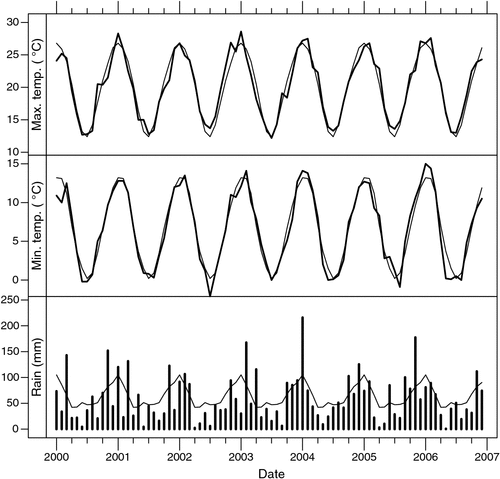
|
The variation in daily minimum and maximum temperatures during the experimental period compared with the long-term climate record (Fig. 1) indicates that both the average daily maximum and minimum temperatures were higher during the summers of 2003, 2004, and 2006 than the long-term average maximum and minimum daily temperatures. It also indicates that, during the winters of 2000, 2002, 2004, and 2006, the average daily minimum temperatures were somewhat lower than those over the long-term climate record. Over the experimental period, there were substantial variations from long-term average temperatures, which are subsequently presented in relation to the frequency of severe frosts.
Figure 2a shows the profiles of rainfall over each year of the Cicerone experiment in conjunction with the mean profile and its 95% confidence region from the other years. Similarly, Fig. 2b shows profiles for the modelled available soil water data. To give a measure of the durations and extent to which rainfall and modelled available soil water over the Cicerone years (2000–06) were outside the 95% confidence region of the long-term averages, the areas between the confidence region and the profiles below or above them were calculated (Table 1). Over the experimental period, less rainfall was received than would have been expected based on the long-term climatic data. In addition, lower levels of available soil water were commonly experienced over the duration of the experiment. The area below the confidence region for rainfall was lower in 4 of the 7 years, while for available soil water, the area below the confidence region was lower in 6 of the 7 years.
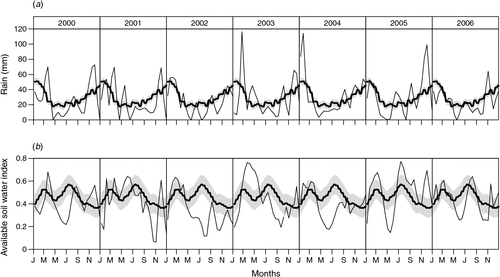
|
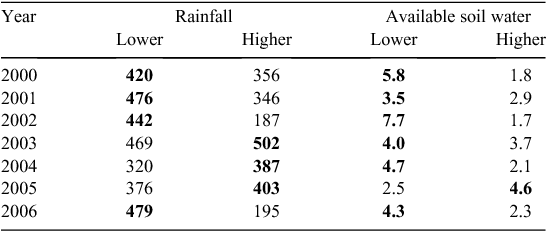
|
The potential for pasture growth during the winter periods was severely limited by cold temperatures. Figure 3 shows the number of frost days recorded at the Armidale weather station during the experimental period compared with the medium-term climate record (1981–2011). The number of frost days experienced during the autumn and winter of 2001, 2002, 2004, 2005, and 2006 exceeded the monthly mean number of frost days over the medium-term record. Note that these frosts generally occurred during dry winter periods, which commonly experience little cloud cover, resulting in severe frosts as shown by the higher frequency of screen temperatures below −5°C during most of the winters throughout the experimental period (Fig. 3).
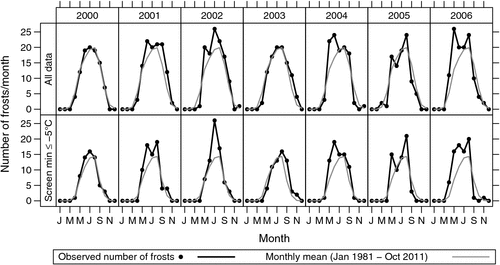
|
Available soil moisture
The modelled available soil moisture index over the experimental period 2000–06 commonly showed months of below-median soil moisture conditions, with relatively fewer months of above-median conditions. When these data are presented as cumulative soil moisture index values (Fig. 4), it is obvious that, especially from autumn 2002 onwards, the cumulative effect of the imbalance between below- and above-median soil moisture conditions resulted in the experiment not reaching median or above-median cumulative soil moisture conditions. A line representing the cumulative 40-percentile soil moisture conditions allows the observation that the soil moisture values were approximately mid-way between the cumulative 40-percentile, which is the cumulative sum of the 40-percentile values for each month, and cumulative median soil moisture values, which are the cumulative sum of the median values for each month. The parts of the cumulative curves with the lowest slope correspond to the periods of lowest soil moisture, whereas the steepest slopes occurred during the relatively few months with above-median available soil moisture conditions. In fact, the Cicerone farmlets experienced below-median soil moisture conditions for 3, 4, or 5 consecutive months during the autumn–winter of 2000, 2002, 2004, 2005, and 2006. Thus, low soil moisture conditions had a large cumulative effect on winter feed supply in 5 of the 7 years of the experiment (Shakhane et al. 2013a) as pasture growth was constrained by both drier and colder than average conditions in winter.
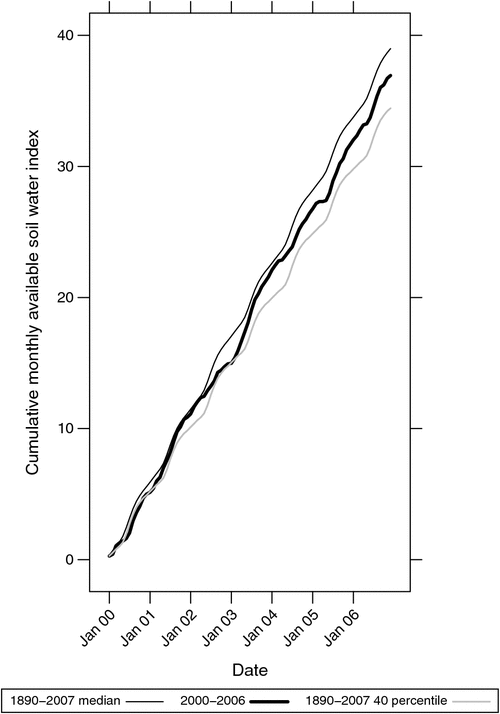
|
Soil moisture stress days
The cumulative number of SMSDs per month, shown in Fig. 5, compares the number of SMSDs over the Cicerone experimental period with the long-term record. It shows that the cumulative number of SMSDs exceeded the cumulative long-term median values, especially from 2002–03 onwards. The divergence from median conditions demonstrates that the levels of moisture stress imposed on pastures were clearly much greater than would be expected if average conditions prevailed over the duration of the experiment. This was especially noticeable during periods when the divergence increased during the period 2002–04.
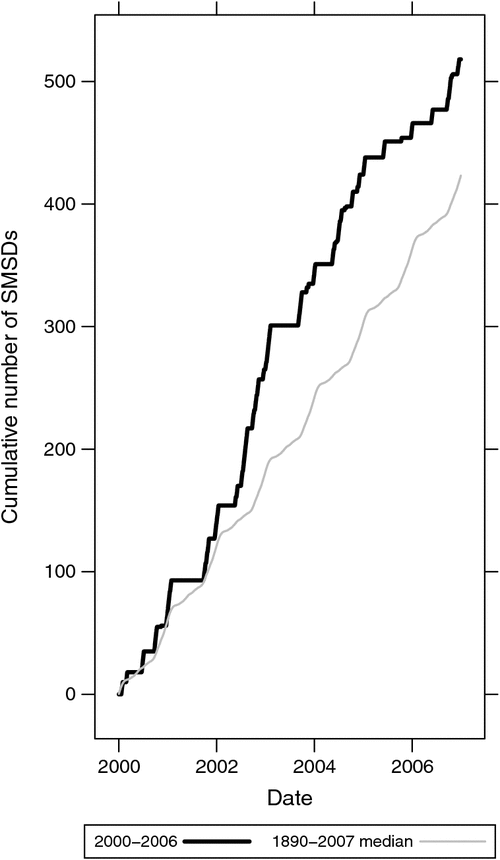
|
Figure 6 shows the annual sum of the number of SMSDs per year over the period 1890–2007. Some years that are widely recognised historically in eastern Australia as having been dry (e.g. 1965, 1982, and 2002) or wet (e.g. 1959, 1973, and 1983) are identified as reference points. It is clear that, over the experimental period (shaded area), the annual number of SMSDs was higher than the long-term mean of 60 days for 4 of the 6 years, with an average from 2000 to 2006 of 75 days/year.
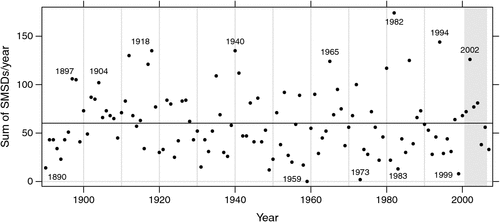
|
Relationship with Southern Oscillation Index
Another measure of the climate experienced over the experimental period is provided in Fig. 7, which shows the SOI relating to sea surface temperatures for each month of the period 1890–2007, including the 6.5-year trial period. Over the experimental period, it is clear that the value of the index was negative (associated with lower rainfall in eastern Australia) in more months than it was positive, especially in 2002, 2004, and 2006.
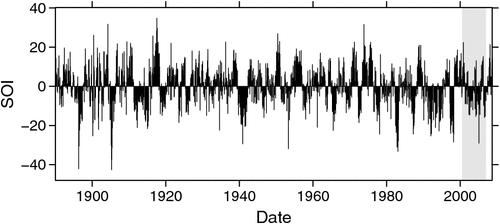
|
Growth indices
Figure 8 shows the annual pattern of changes in indices of light (LI), temperature (TI), soil moisture (MI), and growth (GI) calculated using the procedures of Fitzpatrick and Nix (1975). The seasonal trends in average growth indices indicate that, over the period April–September, temperature tends to be the most limiting factor governing pasture growth. For the remainder of the year, from October through to the next March, soil moisture, on average, is the most limiting factor. It is also noteworthy that conditions for growth are climatically constrained throughout the ‘average’ year, with the growth index never rising above 0.45.
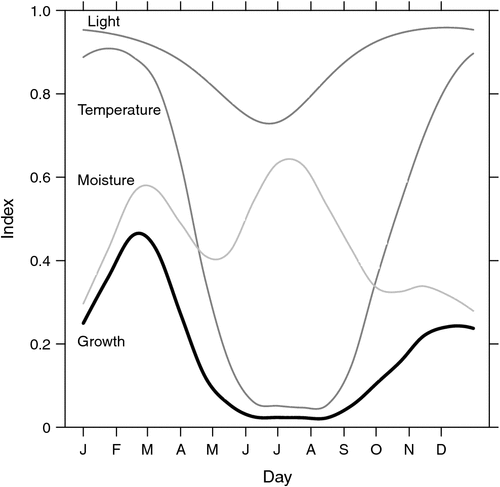
|
The long-term average trends in monthly temperature index are compared with the actual temperature index calculated for the experimental years (2000–06) in Fig. 9. Clearly, the values over the experimental years are closely aligned to the long-term average, with few aberrations. In contrast to the temperature index, changes in the soil moisture index (Fig. 9) show substantial deviations, both above but especially below the long-term average line. Thus, the monthly soil moisture index was above the 70-percentile region in 13 months, whereas it was below the 30-percentile boundary in 23 months. Figure 9 also shows a comparison of the long-term growth index with that calculated for each month of the experimental years. Although occasional peak growth periods are evident (e.g. during late summer in 2002, 2004, and 2005), it is also clear that there were many months when the growth index was at or near zero, especially during the particularly dry winters of 2002, 2004, and 2006 when low levels of soil moisture index were experienced. Thus, these climatic indices show that below-average soil moisture was the feature that most affected the potential for growth over the duration of the field experiment.
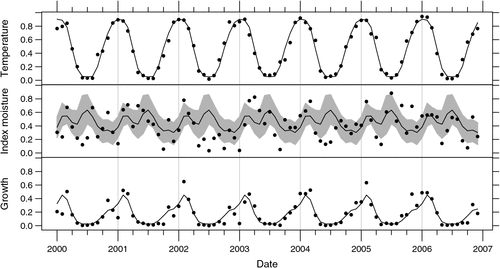
|
Discussion
In this paper, we have compared the climatic conditions experienced by the Cicerone farmlet experiment with the long-term climate record for the region. This has been achieved through the comparison of local climatic data during the experimental period (2000–06) against the long-term record (1890–2007), and through the calculation and assessment of indices known to reflect pasture production. The multi-pronged approach taken has explored differences between short- and long-term records of temperature, rainfall, soil moisture either as an index or as SMSDs, SOI, and calculated growth indices.
Comparison of climatic data revealed that, during the experimental period, the Cicerone farmlets experienced colder and drier winters than the average conditions over the long-term climate record, with more severe frosts occurring over most winters, with the exception of 2003. Both rainfall and available soil water were found to be significantly lower than the long-term climate record over most of the experimental period. How these climatic conditions combine to influence pasture production was assessed through the use of a biophysical model to derive SMSDs, a development from the concept proposed by McCaskill and Blair (1988), and growth indices described by Fitzpatrick and Nix (1975).
These analyses enabled the results of the farmlet experiment to be put into the context of longer term climate variability and the effects of these climatic constraints on pasture production and subsequent farmlet performance. This approach of using models to understand the variability of soil water content has also been used by other researchers, such as Stafford Smith and McKeon (1998) and Lodge and Johnson (2008b). Such studies describe the relationship between soil water content and rainfall over previous consecutive months to define drought or marginal conditions for grassland growth. It is clear that some of the extended periods of several consecutive months of low soil moisture conditions observed in this experiment qualify as ‘drought’ conditions as specified by Lodge and Johnson (2008a).
Although modelling is valuable, as pointed out by Specht (1981) and Bryant and Snow (2008) there is a need for models to adequately account for soil fertility in combination with climatic constraints. It is noteworthy that although livestock producers may be unwilling to adopt higher fertiliser strategies during dry periods (McCaskill and Blair 1988), significant responses to increased soil fertility were observed in the drier than average conditions over this field experiment (Guppy et al. 2013) in both pasture (Shakhane et al. 2013a) and livestock (Cottle et al. 2013; Hinch et al. 2013) production.
Measurement of soil water both within and below the root-zone, as carried out in an earlier trial on an adjacent experimental area (McLeod et al. 2006), would have been desirable; however, resource constraints meant that this was not feasible in the Cicerone farmlet experiment. In these circumstances, modelling has provided valuable estimates of soil water levels and changes over both the short- and long-term. The AusFarm modelling derived a soil moisture index profile of similar shape to that calculated for the same region by Smith and Johns (1975).
During the experimental period, the farmlets experienced few times of above-median conditions that would have allowed production responses to changes in species composition and soil fertility (spring 2005 was an exception). The summaries of modelled soil water over the experimental years show that the Cicerone farmlet experiment was always below cumulative median moisture conditions. In addition, the farmlets experienced comparatively low winter temperatures during the experimental period, with severe frosts occurring during 2001, 2002, 2004, 2005, and 2006. These constraints would no doubt have restricted the responses to pasture inputs and grazing management; evidence of this restriction can be seen in related papers dealing with herbage mass (Shakhane et al. 2013a), remote sensing of normalised difference vegetation index (NDVI), which is related to potential pasture growth (Donald et al. 2013), and livestock weights (Hinch et al. 2013). In the same region, Cook et al. (1976) reported that differences in tolerance to soil fertility and soil moisture constraints could lead to substantial shifts in pasture composition, especially between temperate (C3) species such as Lolium perenne and tropical (C4) species such as Bothriochloa macra. Over the duration of the experiment, large changes in the ratio of C3 to C4 species were observed among farmlets due to treatment effects (Shakhane et al. 2013b).
A comparison of SOI values indicates that they were negative more often than positive during 2002, 2004, and 2006. These dry years are consistent with the pattern of years with lower potential pasture growth found with NDVI images of the Cicerone farmlet experiment (Donald et al. 2013). In addition, climate specialists have noted that fluctuations in the Indian Ocean Dipole (IOD) index are linked to important changes in Australia’s climate, including the recent period since 1995, which they have described as the ‘Big Dry’ (Ummenhofer et al. 2009; Verdon-Kidd and Kiem 2009). This is consistent with the frequency of above- and below-average winter rainfall experienced in the region identified by Carberry et al. (2005).
The analysis of growth indices showed that pasture growth rates in this region are, on average, severely climatically constrained, predominantly by temperature from April to September, and by soil moisture from October to March. In addition, the majority of above-average growth indices occurred during summer when C4 species have an advantage over C3 species. However, the drier than average conditions during spring would have been likely to restrict growth of the legume best adapted to the region, white clover (Hutchinson et al. 1995). This would have potentially constrained the response to phosphorus applications due to limited nitrogen fixation by the legume, which in turn would have limited the amount of nitrogen cycled, resulting in restrictions to grass growth (Sale and Blair 2005).
It is important that livestock producers on the Northern Tablelands appreciate these constraints and consider how they can be managed in spite of the complex interactions of climate with every aspect of a grazing enterprise. The variability of the response in the grazing system under both drier and wetter years is required to more fully understand the interactions between climate and the management strategies studied in the farmlet experiment, namely pasture renovation, fertiliser application and grazing management. The management of the farmlets in response to climatic uncertainty has been conceptually described as a complex decision problem that is familiar to graziers who commonly have to make decisions in spite of imperfect knowledge of the state of a farm’s resources and an uncertain climate (Behrendt et al. 2013a). Rational responses to these climatic constraints include employing deep-rooted perennial species that permit some growth over dry periods (Boschma and Scott 2000) and ensuring the retention of sufficient temperate C3 species, which, especially when adequate soil nitrogen is available, are capable of some modest growth under cold winter temperatures (Newman et al. 1962).
Although severe frosting occurred during the experimental period, this was not evident in the comparison of the short-and long-term temperature index values (Fig. 8). This suggests that the ‘temperature averaging’ procedure used by Fitzpatrick and Nix (1975) may not adequately reflect the effect that severe frosting can have on pasture growth in this region. Similarly, in the GrazPlan suite of models, plant growth is governed by a surrogate for soil temperature, which is computed from mean temperatures during daylight hours (Moore et al. 1997). To enable calibration of the AusFarm model against Cicerone farmlet data, additional management scripts were required to suppress the winter growth of phalaris, the dominant species within the desirable sward (Behrendt 2008). This was necessary, as the temperature-limiting factor for phalaris insufficiently constrained growth compared with other C3 species available in the GrazPlan suite of decision support software (Behrendt 2008).
The range of climate experienced over the experimental period was biased towards drier than average conditions. Ideally, given the marked influence climate has on pasture and livestock outcomes (Jones et al. 1995; O’Reagain et al. 2011), the length of the experimental period for farming systems research should be sufficient to allow adequate representation of the expected range of climatic conditions (Walker 1988). This would enable sufficient demonstration of treatment responses and would reduce the need for assumptions or modelling to extrapolate responses to climatic conditions for which there are no data to support calibration. The analyses reported here reinforce the case made by Jones et al. (1995) that funding organisations need to support dryland farming systems research trials for periods sufficient to allow for realistic appraisals of the systems under investigation.
Accepting the results of the experiment without consideration of potential outcomes under an alternative sequence of years could lead to erroneous conclusions. This paper has attempted to provide a climatic context within which the results presented in related papers, such as changes in botanical composition (Shakhane et al. 2013b), herbage mass and quality (Shakhane et al. 2013a), liveweights (Hinch et al. 2013), economic risk (Scott et al. 2013a), and integrated outcomes (Scott et al. 2013b) can be viewed. Because these results were obtained over a limited period, several other related papers in this Special Issue have focussed on system optimisation over the longer term (Behrendt et al. 2013a, 2013b; Scott et al. 2013a).
Through a comparison of climatic data over the experimental period, and the use of biophysical modelling and growth indices against the long-term record, this paper has demonstrated a method of assessing whether a dryland farming system experiment experienced a sufficiently representative climate for the region during the trial period. Key deviations from the expected long-term climate for the region were identified in the frequency of severe frosts during the abnormally dry winters of 2002, 2004, and 2006. In addition, the analysis of rainfall, available soil water data, and SMSDs showed that the Cicerone farmlet experiment experienced moisture-constrained conditions throughout most of the experimental period. This was supported by the comparison of growth indices against the long-term indices. The analysis suggests that the Cicerone farmlet experiment did not experience climatic conditions typical of the long-term record. This would have restricted the responses observed to pasture inputs and grazing management, and hence the results from the experiment should be interpreted with due regard to climatic expectations over the long-term.
Acknowledgements
The funding for the Cicerone Project was provided primarily by woolgrowers and the Australian taxpayer through Australian Wool Innovation. Additional funds were provided by the Australian Sheep CRC and the University of New England with important in-kind contributions from NSW Department of Primary Industries, the University of New England, and CSIRO. The contribution of Paul Carberry, formerly of NSW Department of Primary Industries, to the analysis of the climate experienced during the Cicerone Project is gratefully acknowledged. In addition we acknowledge the contribution made by Graham Donald, CSIRO, during preparation of this manuscript.
References
Anon. (2006) ‘AusFarm: A tutorial.’ (CSIRO Plant Industry: Canberra)Auld BA, Medd RW (1987) ‘Weeds: An illustrated botanical guide to the weeds of Australia.’ (Inkata Press Pty Ltd: Melbourne)
Behrendt K (2008) Bioeconomics of pasture resource development in sheep production systems. PhD thesis. University of New England, NSW.
Behrendt K, Cacho O, Scott JM, Jones R (2013a) Optimising pasture and grazing management decisions on the Cicerone Project farmlets over variable time horizons. Animal Production Science 53, 796–805.
| Optimising pasture and grazing management decisions on the Cicerone Project farmlets over variable time horizons.Crossref | GoogleScholarGoogle Scholar |
Behrendt K, Scott JM, Cacho O, Jones R (2013b) Simulating the impact of fertiliser strategies and prices on the economics of developing and managing the Cicerone Project farmlets under climatic uncertainty. Animal Production Science 53, 806–816.
| Simulating the impact of fertiliser strategies and prices on the economics of developing and managing the Cicerone Project farmlets under climatic uncertainty.Crossref | GoogleScholarGoogle Scholar |
Boschma SP, Scott JM (2000) Measuring and predicting the consequences of drought for a range of perennial grasses on the Northern Tablelands of New South Wales. Australian Journal of Experimental Agriculture 40, 285–297.
| Measuring and predicting the consequences of drought for a range of perennial grasses on the Northern Tablelands of New South Wales.Crossref | GoogleScholarGoogle Scholar |
Bryant JR, Snow V (2008) Modelling pastoral farm agro-ecosystems: a review. New Zealand Journal of Agricultural Research 51, 349–363.
| Modelling pastoral farm agro-ecosystems: a review.Crossref | GoogleScholarGoogle Scholar |
Bureau of Meteorology (2011) S.O.I. (Southern Oscillation Index) Archives – 1876 to present. Bureau of Meteorology. Available at http://www.bom.gov.au/climate/current/soihtm1.shtml [Verified 24 June 2013]
Carberry PM, Hinch GN, Scott JM (2005) New England climate and its problems for producers. In ‘The Cicerone Farms: under the microscope’. (Ed. JM Scott) pp. 1–4. (The Cicerone Project Inc. and Centre for Sustainable Farming Systems, University of New England: Armidale, NSW)
Cook SJ, Lazenby A, Blair GJ (1976) Comparative responses of Lolium perenne and Bothriochloa macra to temperature, moisture, fertility and defoliation. Australian Journal of Agricultural Research 27, 769–778.
| Comparative responses of Lolium perenne and Bothriochloa macra to temperature, moisture, fertility and defoliation.Crossref | GoogleScholarGoogle Scholar | 1:CAS:528:DyaE2sXhsFKquw%3D%3D&md5=6fab6774210198ec752c6a51ebead480CAS |
Cottle D, Gaden CA, Hoad J, Lance D, Smith J, Scott JM (2013) The effects of pasture inputs and intensive rotational grazing on superfine wool production, quality and income. Animal Production Science 53, 750–764.
| The effects of pasture inputs and intensive rotational grazing on superfine wool production, quality and income.Crossref | GoogleScholarGoogle Scholar |
CSIRO (2007) ‘AusFarm.’ (CSIRO Plant Industry: Canberra, ACT)
Donald GE, Scott JM, Vickery PJ (2013) Satellite derived evidence of whole farmlet and paddock responses to management and climate. Animal Production Science 53, 699–710.
| Satellite derived evidence of whole farmlet and paddock responses to management and climate.Crossref | GoogleScholarGoogle Scholar |
Donnelly JR, Moore AD, Freer M (1997) GRAZPLAN: decision support systems for Australian grazing enterprises-I. Overview of the GRAZPLAN project, and a description of the MetAccess and LambAlive DSS. Agricultural Systems 54, 57–76.
Donnelly JR, Freer M, Salmon L, Moore AD, Simpson RJ, Dove H, Bolger TP (2002) Evolution of the GRAZPLAN decision support tools and adoption by the grazing industry in temperate Australia. Agricultural Systems 74, 115–139.
| Evolution of the GRAZPLAN decision support tools and adoption by the grazing industry in temperate Australia.Crossref | GoogleScholarGoogle Scholar |
Fitzpatrick EA, Nix HA (1975) The climate factor in Australian grassland ecology. In ‘Australian grasslands’. (Ed. RM Moore) pp. 3–26. (A.N.U. Press: Canberra, ACT)
George JM, Vickery PJ, Wilson MA (1977) ‘Meteorological data from the CSIRO Pastoral Research Laboratory, Armidale, N. S.W., 1949–1976.’ (CSIRO: Melbourne)
Guppy CN, Edwards C, Blair GJ, Scott JM (2013) Whole-farm management of soil nutrients drives productive grazing systems: the Cicerone farmlet experiment confirms earlier research. Animal Production Science 53, 649–657.
| Whole-farm management of soil nutrients drives productive grazing systems: the Cicerone farmlet experiment confirms earlier research.Crossref | GoogleScholarGoogle Scholar |
Hinch GN, Hoad J, Lollback M, Hatcher S, Marchant R, Colvin A, Scott JM, Mackay D (2013) Livestock weights in response to three whole-farmlet management systems. Animal Production Science 53, 727–739.
| Livestock weights in response to three whole-farmlet management systems.Crossref | GoogleScholarGoogle Scholar |
Hutchinson KJ, King KL, Wilkinson DR (1995) Effects of rainfall, moisture stress, and stocking rate on the persistence of white clover over 30 years. Australian Journal of Experimental Agriculture 35, 1039–1047.
| Effects of rainfall, moisture stress, and stocking rate on the persistence of white clover over 30 years.Crossref | GoogleScholarGoogle Scholar |
Johnson IR (1997) Climate and pasture production. In ‘Pasture production and management’. (Ed. JS JV Lovett) pp. 17–32. (Inkata Press: Melbourne)
Johnson IR, Lodge GM, White RE (2003) The Sustainable Grazing Systems Pasture Model: description, philosophy and application to the SGS National Experiment. Australian Journal of Experimental Agriculture 43, 711–728.
| The Sustainable Grazing Systems Pasture Model: description, philosophy and application to the SGS National Experiment.Crossref | GoogleScholarGoogle Scholar |
Jones RM, Jones RJ, McDonald CK (1995) Some advantages of long-term grazing trials, with particular reference to changes in botanical composition. Australian Journal of Experimental Agriculture 35, 1029–1038.
| Some advantages of long-term grazing trials, with particular reference to changes in botanical composition.Crossref | GoogleScholarGoogle Scholar |
Kahn L, Heard B, Whalley W (2003) ‘Pasture plants of the Slopes and Tablelands of NSW: a field guide to the recognition and attributes of 70 plants.’ (Department of Land and Water Conservation, University of New England: Armidale, NSW)
Katz R, Brown B (1992) Extreme events in a changing climate: variability is more important than averages. Climatic Change 21, 289–302.
| Extreme events in a changing climate: variability is more important than averages.Crossref | GoogleScholarGoogle Scholar |
Keating BA, McCown RL (2001) Advances in farming systems analysis and intervention. Agricultural Systems 70, 555–579.
| Advances in farming systems analysis and intervention.Crossref | GoogleScholarGoogle Scholar |
Kelly AM, Basford KE (2000) Pattern analysis in grassland and animal production systems. In ‘Field and laboratory methods for grassland and animal production research’. (Eds L ’t Mannetje, RM Jones) pp. 9–28. (CABI Publishing: Wallingford, UK)
Laws JA, Pain BF, Jarvis SC, Scholefield D (2000) Comparison of grassland management systems for beef cattle using self-contained farmlets: effects of contrasting nitrogen inputs and management strategies on nitrogen budgets, and herbage and animal production. Agriculture, Ecosystems & Environment 80, 243–254.
| Comparison of grassland management systems for beef cattle using self-contained farmlets: effects of contrasting nitrogen inputs and management strategies on nitrogen budgets, and herbage and animal production.Crossref | GoogleScholarGoogle Scholar |
Lodge GM, Johnson IR (2008a) Agricultural drought analyses for temperate Australia using a biophysical pasture model. 1. Identifying and characterising drought periods. Australian Journal of Agricultural Research 59, 1049–1060.
| Agricultural drought analyses for temperate Australia using a biophysical pasture model. 1. Identifying and characterising drought periods.Crossref | GoogleScholarGoogle Scholar |
Lodge GM, Johnson IR (2008b) Agricultural drought analyses for temperate Australia using a biophysical pasture model. 2. Relationship between rainfall and the start and end of predicted droughts. Australian Journal of Agricultural Research 59, 1061–1067.
| Agricultural drought analyses for temperate Australia using a biophysical pasture model. 2. Relationship between rainfall and the start and end of predicted droughts.Crossref | GoogleScholarGoogle Scholar |
McCaskill MR, Blair GJ (1988) Medium-term climatic variation of the Northern Tablelands of NSW. Mathematics and Computers in Simulation 30, 159–164.
| Medium-term climatic variation of the Northern Tablelands of NSW.Crossref | GoogleScholarGoogle Scholar |
McLeod MK, MacLeod DA, Daniel H (2006) The effect of degradation of phalaris plus white clover pasture on soil water regimes of a Brown Chromosol on the Northern Tablelands of NSW, Australia. Agricultural Water Management 82, 318–342.
| The effect of degradation of phalaris plus white clover pasture on soil water regimes of a Brown Chromosol on the Northern Tablelands of NSW, Australia.Crossref | GoogleScholarGoogle Scholar |
Medd RW, Smith RCG (1978) Prediction of the potential distribution of Carduus nutans (nodding thistle) in Australia. Journal of Applied Ecology 15, 603–612.
| Prediction of the potential distribution of Carduus nutans (nodding thistle) in Australia.Crossref | GoogleScholarGoogle Scholar |
Moore AD (2001) FarmWi$e: a flexible decision support tool for grazing systems management. In ‘Proceedings XIX International Grassland Congress’. São Paulo, Brazil. ID# 32-03 (International Grassland Congress) Available at http://www.internationalgrasslands.org/files/igc/publications/2001/id3203.pdf [Verified 24 June 2013]
Moore AD (2009) Opportunities and trade-offs in dual-purpose cereals across the southern Australian mixed-farming zone: a modelling study. Animal Production Science 49, 759–768.
| Opportunities and trade-offs in dual-purpose cereals across the southern Australian mixed-farming zone: a modelling study.Crossref | GoogleScholarGoogle Scholar |
Moore AD, Donnelly JR, Freer M (1997) GRAZPLAN: Decision Support Systems for Australian Grazing Enterprises. III. Pasture Growth and Soil Moisture Submodels, and GrassGro DSS. Agricultural Systems 55, 535–582.
| GRAZPLAN: Decision Support Systems for Australian Grazing Enterprises. III. Pasture Growth and Soil Moisture Submodels, and GrassGro DSS.Crossref | GoogleScholarGoogle Scholar |
Nason GR (2008) ‘Wavelet methods in statistics in R.’ (Springer: New York)
Newman R, Allen B, Cook M (1962) The effect of nitrogen on winter pasture production in southern Victoria. Australian Journal of Experimental Agriculture 2, 20–24.
| The effect of nitrogen on winter pasture production in southern Victoria.Crossref | GoogleScholarGoogle Scholar |
O’Reagain P, Bushell J, Holmes B (2011) Managing for rainfall variability: long-term profitability of different grazing strategies in a northern Australian tropical savanna. Animal Production Science 51, 210–224.
| Managing for rainfall variability: long-term profitability of different grazing strategies in a northern Australian tropical savanna.Crossref | GoogleScholarGoogle Scholar |
Russell JS (1981) Geographic variation in seasonal rainfall in Australia – an analysis of the 80-year period 1895–1974. The Journal of the Australian Institute of Agricultural Science 47, 59–66.
Sale PWG, Blair G (2005) Fertilisers and pasture nutrition. In ‘Pasture production and management’. (Eds JV Lovett, JM Scott) pp. 191–206. (Inkata Press: Melbourne)
Schafer BM (1980) A description of the soils on the CSIRO Pastoral Research Laboratory property, Chiswick, Armidale, NSW. Technical Paper No. 8. CSIRO Animal Research Laboratories, Armidale, NSW.
Scott JF, Cacho OJ, Scott JM (2013a) Economic risk analysis of livestock management system options. Animal Production Science 53, 788–795.
| Economic risk analysis of livestock management system options.Crossref | GoogleScholarGoogle Scholar |
Scott JM, Behrendt K, Colvin A, Scott F, Shakhane LM, Guppy C, Hoad J, Gaden CA, Edwards C, Hinch GN, Cacho OJ, Donald GE, Cottle D, Coventry T, Williams G, Mackay DF (2013b) Integrated overview of results from a farmlet experiment which compared the effects of pasture inputs and grazing management on profitability and sustainability. Animal Production Science 53, 841–855.
| Integrated overview of results from a farmlet experiment which compared the effects of pasture inputs and grazing management on profitability and sustainability.Crossref | GoogleScholarGoogle Scholar |
Scott JM, Gaden CA, Edwards C, Paull DR, Marchant R, Hoad J, Sutherland H, Coventry T, Dutton P (2013c) Selection of experimental treatments, methods used and evolution of management guidelines for comparing and measuring three grazed farmlet systems. Animal Production Science 53, 628–642.
| Selection of experimental treatments, methods used and evolution of management guidelines for comparing and measuring three grazed farmlet systems.Crossref | GoogleScholarGoogle Scholar |
Scott JM, Munro M, Rollings N, Browne W, Vickery PJ, Macgregor C, Donald GE, Sutherland H (2013d) Planning for whole-farm systems research at a credible scale: subdividing land into farmlets with equivalent initial conditions. Animal Production Science 53, 618–627.
| Planning for whole-farm systems research at a credible scale: subdividing land into farmlets with equivalent initial conditions.Crossref | GoogleScholarGoogle Scholar |
Shakhane LM, Mulcahy C, Scott JM, Hinch GN, Donald GE, Mackay DF (2013a) Pasture herbage mass, quality and growth in response to three whole-farmlet management systems. Animal Production Science 53, 685–698.
| Pasture herbage mass, quality and growth in response to three whole-farmlet management systems.Crossref | GoogleScholarGoogle Scholar |
Shakhane LM, Scott JM, Murison R, Mulcahy C, Hinch GN, Morrow A, Mackay DF (2013b) Changes in botanical composition on three farmlets subjected to different pasture and grazing management strategies. Animal Production Science 53, 670–684.
| Changes in botanical composition on three farmlets subjected to different pasture and grazing management strategies.Crossref | GoogleScholarGoogle Scholar |
Shakhane LM, Scott JM, Hinch GN, Mackay DF, Lord C (2013c) Estimating the balance between pasture feed supply and demand of grazing livestock in a farmlet experiment. Animal Production Science 53, 711–726.
| Estimating the balance between pasture feed supply and demand of grazing livestock in a farmlet experiment.Crossref | GoogleScholarGoogle Scholar |
Smith RCG, Johns GG (1975) Seasonal trends and variability of soil moisture under temperate pasture on the northern tablelands of New South Wales. Australian Journal of Experimental Agriculture and Animal Husbandry 15, 250–255.
| Seasonal trends and variability of soil moisture under temperate pasture on the northern tablelands of New South Wales.Crossref | GoogleScholarGoogle Scholar |
Specht RL (1981) Growth indices—Their rôle in understanding the growth, structure and distribution of Australian vegetation. Oecologia 50, 347–356.
| Growth indices—Their rôle in understanding the growth, structure and distribution of Australian vegetation.Crossref | GoogleScholarGoogle Scholar |
Stafford Smith DM, McKeon GM (1998) Assessing the historical frequency of drought events on grazing properties in Australian rangelands. Agricultural Systems 57, 271–299.
| Assessing the historical frequency of drought events on grazing properties in Australian rangelands.Crossref | GoogleScholarGoogle Scholar |
Sutherland H, Scott JM, Gray GD, Woolaston RR (2013) Creating the Cicerone Project: seeking closer engagement between livestock producers, research and extension. Animal Production Science 53, 593–601.
| Creating the Cicerone Project: seeking closer engagement between livestock producers, research and extension.Crossref | GoogleScholarGoogle Scholar |
Tothill JC, Hargraves JNG, Jones RM (1978) ‘BOTANAL—A comprehensive sampling and computing procedure for estimating pasture yield and composition. 1. Field sampling.’ (CSIRO Division of Tropical Crops and Pastures: St Lucia, Qld)
Tucker GB (1975) Climate: is Australia’s changing? Search 6, 323–328.
Ummenhofer CC, England MH, McIntosh PC, Meyers GA, Pook MJ, Risbey JS, Sen Gupta A, Taschetto AS (2009) What causes southeast Australia’s worst droughts? Geophysical Research Letters 36, L04706
| What causes southeast Australia’s worst droughts?Crossref | GoogleScholarGoogle Scholar |
Verdon-Kidd DC, Kiem AS (2009) Nature and causes of protracted droughts in southeast Australia: comparison between the Federation, WWII, and Big Dry droughts. Geophysical Research Letters 36, L22707
| Nature and causes of protracted droughts in southeast Australia: comparison between the Federation, WWII, and Big Dry droughts.Crossref | GoogleScholarGoogle Scholar |
Walker BH (1988) Autecology, synecology, climate and livestock as agents of rangeland dynamics. Australian Rangeland Journal 10, 69–75.
| Autecology, synecology, climate and livestock as agents of rangeland dynamics.Crossref | GoogleScholarGoogle Scholar |
Whalley R, Robinson G, Taylor J (1976) General effects of management and grazing by domestic livestock on the rangelands of the Northern Tablelands of New South Wales. The Rangeland Journal 1, 174–190.
| General effects of management and grazing by domestic livestock on the rangelands of the Northern Tablelands of New South Wales.Crossref | GoogleScholarGoogle Scholar |
Wheeler DJB, Jacobs SWL, Norton BE (1982) ‘Grasses of New South Wales. Vol. 3.’ (The University of New England: Armidale, NSW)


